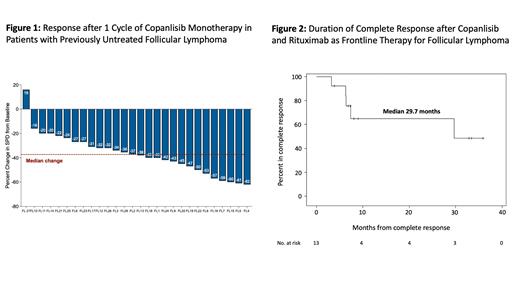Introduction
Frontline therapy for pts with follicular lymphoma (FL) is not based on the molecular profile of the tumor. The PI3K pathway is central to FL biology, but the molecular profile of tumors most sensitive to PI3K inhibition (PI3Ki) is unknown. Copanlisib inhibits both PI3Kα and δ isoforms, and we hypothesized that most pts with treatment naïve FL will have PI3Ki-sensitive tumors and durable complete responses (CRs) may be achievable with short durations of targeted therapy. A gene expression profiling (GEP) predictor utilizes a combination of the expression of 45 selected informative genes and an additional 19 housekeeping genes to identify FL pts at high-risk for early progression within 24 months (Wright et al. ASH Annual Meeting2022). We also hypothesized that copanlisib would induce durable CRs in high-risk pts by the GEP assay. Here, we report a preliminary analysis of an ongoing “window of opportunity” study of copanlisib followed by response-adapted copanlisib and rituximab in treatment-naïve pts with FL (NCT03789240).
Methods
Pts with untreated grade 1-2, 3A FL, ≥stage 2 are eligible if systemic therapy is indicated: symptoms, progressive lymphadenopathy, or organ compromise. Prior radiation is permitted. Eligibility includes age ≥18 and adequate organ function unless due to lymphoma. HIV, CMV, Hep B or C, and autoimmune conditions are excluded. Pts first receive copanlisib 60mg on days 1, 8, and 15 of a 28-day “window of opportunity” to explore the activity of copanlisib. Following the window, pts receive 6 cycles of copanlisib 60mg on days 1, 8, and 15 of a 28-day cycle along with rituximab 375mg weekly x 4 then on day 1 of each cycle and response is assessed with FDG-PET and CT scans. Pts without response after C6 are taken off study and those with a partial response (PR) can continue for an additional 6 cycles and then stop therapy. Pts who achieve a CR after 6 cycles stop therapy. No maintenance is given. Supportive care includesPCP prophylaxis. The primary endpoint is the CR rate with secondary endpoints of safety, duration of CR, and PFS. Exploratory objectives include identification of a predictive signature of PI3Ki response and the response rate in high-risk pts identified by the GEP assay.
Results
Twenty-eight pts have enrolled. Median age was 56y (range, 24-80). Seventeen (61%) and 12 (43%) pts had high-risk FLIPI and FLIPI-2 scores ≥3, respectively; 6 (21%) pts had Grade 3A FL, and 17 (61%) pts met two or more GELF criteria. After copanlisib monotherapy in the window, 27 (96%) pts had tumor reductions by CT with a median change of -38% (-62% to +16%) (Figure 1). Among 22 pts who completed 6 cycles, 21 (96%) responded, including 9 (41%) pts with PR and 12 (55%) pts with CR. Of 9 pts with PR who received an additional 6 cycles of therapy, only 1 (11%) converted to a CR bringing the overall CR rate to 59% (13/22 pts). After a median follow-up of 25.8 months, the 2-year PFS was 43.2% (95% CI, 20.7-64.0%). The median duration of CR was 29.7 months (95% CI, 6.3 months - not estimable) with 8 (62%) CRs ongoing (Figure 2). Toxicity was evaluated in 28 pts across 220 cycles. Most common were rash (64%), mucositis (50%), and nausea/vomiting (50%), all G1-2 except 1 (4%) pt with G3 mucositis. The most common ≥G3 toxicities were neutropenia and infections in 5 (18%) pts each. ≥G3 neutropenia occurred in 10 (5%) cycles, responded to therapy interruption and/or growth factors, and did not require dose reduction. Two (8%) pts had copanlisib dose reduced, 1 (4%) each due to rash and mucositis. Therapy was prematurely discontinued in 5 pts: 3 due to COVID-19, 1 for hepatotoxicity that resolved, and 1 due to infusion reaction to rituximab.
Nine of 24 (38%) pts were poor risk by the GEP assay. Complete responses were observed in 71%, 67%, and 57% of pts categorized as high-risk by FLIPI, FLIPI-2, and GEP assay, respectively. The CR rate was not affected by bulky disease (any LN >7cm; p=1.00), high-risk FLIPI (p=0.19), high-risk FLIPI-2 (p=0.67), poor-risk GEP (p=1.00), or metabolic tumor volume (p=0.33).
Conclusion
Nearly all pts with treatment naïve FL have PI3Ki-responsive tumors, and the combination of copanlisib with rituximab achieved a CR rate of 59% at the end of induction therapy. The median duration of CR is nearly 30 months, including ongoing remissions without maintenance. CRs were observed in pts deemed high-risk by the GEP assay and FLIPI score. The safety profile is excellent, with mostly G1-2 toxicities manageable with supportive care.
Disclosures
Rimsza:Roche: Other: Consulting; NanoString: Other: Licensed intellectual property. Meerson:BostonGene: Current Employment, Current equity holder in private company, Current holder of stock options in a privately-held company. Postovalova:BostonGene, Corp.: Current Employment, Current equity holder in private company, Current holder of stock options in a privately-held company, Patents & Royalties. Bagaev:BostonGene: Current Employment, Current equity holder in private company, Current holder of stock options in a privately-held company, Patents & Royalties: patents. Fowler:CelGene: Consultancy, Research Funding; Roche: Consultancy, Research Funding; Gilead: Consultancy, Research Funding; BostonGene: Current Employment, Current equity holder in private company, Current holder of stock options in a privately-held company.


This feature is available to Subscribers Only
Sign In or Create an Account Close Modal